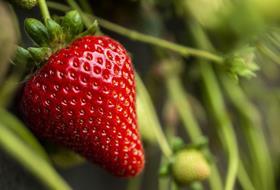
Researchers claim they can boost strawberry shelf life with a new stimulant to improve calcium uptake on the plant.
Scientists at Levity Crop Science say strawberries turn mouldy and mushy from an inability to absorb calcium fertiliser while ripening, with calcium top-ups from growers close to harvest proving ineffective in firming strawberry cell membranes.
More than 38,000 tonnes of soft fruit, worth around £180 million, are thrown away by UK households each year after turning bad, with strawberries among the most-binned berry.
The Lancashire-based Levity Crop Science hope its breakthrough can help cut this number down by changing the way they are grown.
“The plant needs calcium to build strong cell walls, but it’s the premature breakdown of these cell membranes that makes fruit go soft. It’s at this point it rapidly succumbs to mould,” said Dr David Marks, managing director of Levity Crop Science.
“Unlike other fruits – bananas and apples, for example – strawberries don’t ripen in response to a gas, ethylene, produced by the plant. Instead, they have a gene that responds to falling levels of another plant hormone, called auxin. But auxin is also involved in moving calcium around the plant – so once the fruit starts to ripen, calcium can’t be properly absorbed.”
Dr Marks led his team to look at a group of naturally occurring compounds called calcium transport stimulants. These emulate auxins and have already been used to prevent bitter pit, an apple disease related to calcium deficiency.
Based on this, Levity Crop Science developed their own calcium transport stimulant, the team mixed it with the standard calcium fertiliser used by strawberry growers.
“Of the fruit from plants treated with the new stimulant, nearly two-thirds was of marketable quality, compared to less than half of the fruit from the plants treated with standard calcium,” Marks continued.
“The quality of fruit in the field has a direct bearing on how long the berries last after picking, and thus how quickly they will mould.
“We now need further research to establish beyond doubt how much extra shelf life this can deliver for the consumer. But it’s definitely good news for strawberry growers: not only will they be able to sell a greater proportion of their crop after treatment with this product, they will also be able to reduce the amount of calcium they apply. It’s why we’ve called the technology LoCal – growers can reduce the average amount of calcium needed by two-thirds.”



